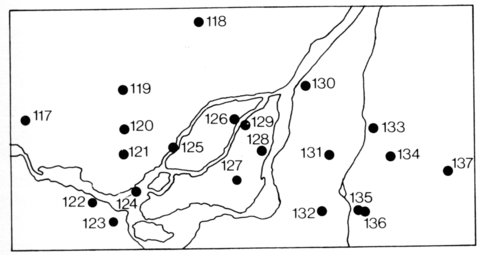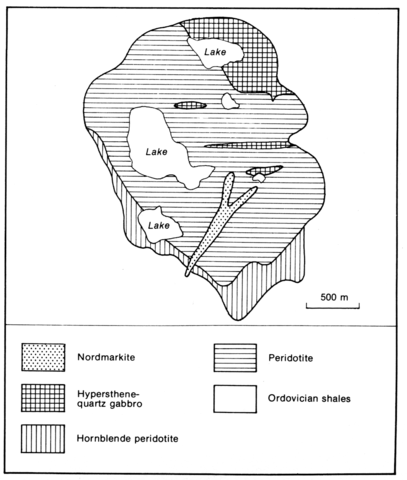stripes
Mount Bruno is an irregular elliptical intrusion of 3.2x2.5 km, forming a low, wooded hill of poor exposure and occupied by three lakes. Surrounding Ordovician shales are hornfelsed. The principal rock type is a feldspathic peridotite, referred to as essexite in older publications, with an approximately concentric and vertical or inward, steeply-dipping foliation; there is also some layering. Olivine (Fo84-78) and titanaugite are dominant with ubiquitous plagioclase (An69-60) increasing towards the centre of the intrusion, the rock becoming a layered gabbro. Kaersutite and locally nepheline occur along the southern margin, and biotite, magnetite and apatite are also present. Eby (1984a and personal communication, 1984) considers that these rocks are pyroxenites gradational to gabbros, and he does not distinguish the rock designated hornblende peridotite by Philpotts (see Fig. 64). Hypersthene-quartz gabbro occurs in the northeast and also forms dykes cutting the peridotite. A dyke-like mass of nordmarkite, formerly called umptekite, occurs in the southern part of the intrusion and comprises perthite, plagioclase, quartz, biotite, ferrohastingsite and aegirine-augite. There are numerous lamprophyric sills and dykes within the hornfelses with olivine and pyroxene phenocrysts; bostonite dykes are present also. A camptonite dyke from the western hornfels collar containing felsic ocelli is described by Philpotts (1976, p. 1151). Chemical analyses, including REE and Sr isotope data, will be found in Eby (1984a).
CURRIE, K.L. 1976a. The alkaline rocks of Canada. Bulletin, Geological Survey of Canada, 239: 1-228.
DRESSER, J.A. 1910. Geology of St. Bruno Mountain. Memoir, Geological Survey of Canada, 7: 1-33.
EBY, G.N. 1984a. Monteregian Hills I. Petrography, major and trace element geochemistry, and strontium isotopic chemistry of the western intrusions: Mounts Royal, St. Bruno, and Johnson. Journal of Petrology, 25: 421-52.
EBY, G.N. 1984b. Geochronology of the Monteregian Hills alkaline igneous province, Quebec. Geology, 12: 468-70.
EBY, G.N. 1985b. Sr and Pb isotopes, U and Th chemistry of the alkaline Monteregian and White Mountain igneous provinces, eastern North America. Geochimica et Cosmochimica Acta, 49: 1143-53.
PHILPOTTS, A.R. 1969. Notes on the geology of Mt. Bruno. In Geology of the Monteregian Hills (Ed. G. Pouliot). Geological Association of Canada- Mineralogical Association of Canada, Guidebook: 75-6.
PHILPOTTS, A.R. 1976. Silicate liquid immiscibility: its probable extent and petrogenetic significance. American Journal of Science, 276: 1147-77.


